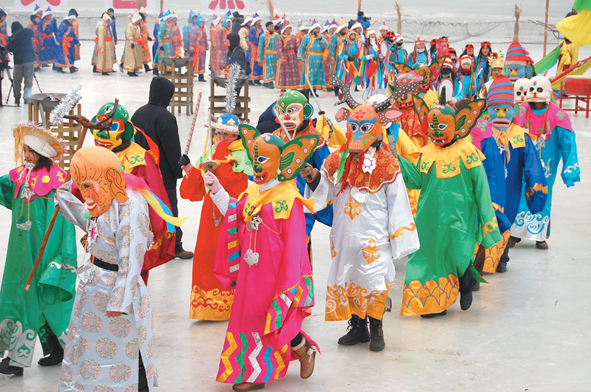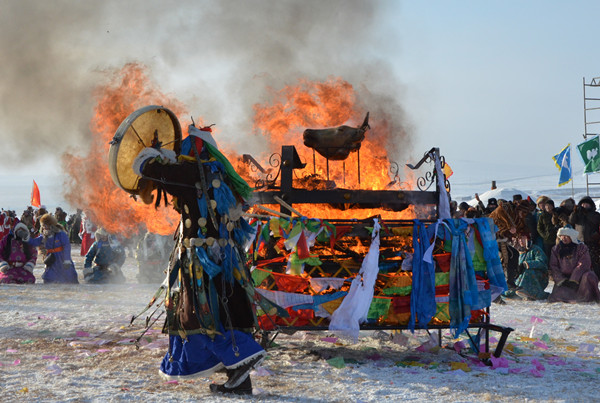Mongolian religious dance
Dance Tsam
 |
A Tsam ceremony was held at the beginning of the year to exorcise evil. It consisted of a series of masked dances and often had a narrative content.[Photo/nmg.gov.cn] |
Historically, Tsam ceremonies were held at the beginning of the year to exorcise evil. Meaning ‘masked dance’, the performances often had a narrative content. Today in Mongolia efforts are being made to revive the tradition, with elderly monks who survived persecution teaching young monks the rituals and choreography of Tsam.
While the use of grotesque masks in the Tsam dances creates an impression of returning high antiquity, the festival is in fact a relatively recent tradition. The rituals include tantric and much older shamanistic traditions of dance merged in a harmonious fashion. Mongolian shamanism may have owed its great vitality and dynamism to the fact that it had already absorbed various tantric elements when Buddhism first reached Mongolia. The shamanistic influence, as it manifests itself in the Tsam festival, is therefore a multi-layered phenomenon, the different strata of which cannot always be clearly distinguished from one another.
In the past, the mysterious dances were of considerable significance in Mongolia and always accompanied by music. For these ritual dances the monks wore dance masks made of papier maché. The Tsam symbolized the battle of the gods against the enemies. In animism, the oldest form of religious belief (e.g. the Bon-religion), one believes that the whole nature is animated - human beings and animals are surrounded by good and evil spirits.
The Mongolian people worship an important god of fertility, who is represented by the mask of an amiable, white-haired and white-bearded old man with waggish and cunning features. He is considered the master of earth and water. His attributes, such as white clothes and a wand with a dragonhead, are reminiscent of shamanism. He is the main figure in the Tsam dance, in which he appears in the role of a clown and dolt.
Mongolian masks symbolizing the actual presence of a deity never have their eyes pierced. The performers therefore had to look through the mouths of the masks, adding extra height to the performer. As the temporary residence of gods and demons, masks are like statues and treated as sacred objects. When not in use, they were stored in monasteries and worshipped in daily rituals.
Shaman Dance
 |
Shaman Dance is performed by shaman (sorcerers or witches) by praying to gods, sacrificing, dispelling evils and curing diseases. |
Shaman Dance is performed by shaman (sorcerers or witches) by praying to gods, sacrificing, dispelling evils and curing diseases, and is commonly known as Tiaodashen[please confirm spelling: Tiaodashen or Tiaojiashen]. The dance was popular among northern Chinese tribes, a result of primitive hunting, fishing and totem worshipping activities.
Today, one can find relics of primitive cultures in the clothes, musical instruments and dance movements of shaman. For example, shaman of the Oroqin and Ewenki people always decorate their clothes with beast bones or teeth; their musical instrument Zhuagu (a hand-held drum) is covered with beast skin, and their performances imitate images of bears, hawks and deer.
In the past, to meet the demands of a hunting lifestyle, nomadic tribes lived dispersedly in yurts. Except for large carnivals (such as the Nadam Fair in Mongolia today), all dances are done within the yurt. Therefore, their dances are usually small in scale. The dance style is straightforward and bold, with few steps, but the arm actions are powerful, and the wrist, shoulder and waist move briskly. In the dance, there are images and actions of hawks, swans and horse riding, and the "Shaman Dance" originating from religious beliefs is the most common type.
The Manchu people call the Shaman Dance Tiaojiashen [please confirm spelling: Tiaodashen or Tiaojiashen
](inviting gods of the house) or Shaoqixiang (the Manchu people invite the gods). The shaman ties a long bell to his or her waist in performance and holds a drum. Gods in charge of different sectors of people's lives are invited at the sound of drums and the bells. After each god arrives, the shaman will imitate the movements of the god. For instance, if he has invited the God of Hawk, he will imitate flying and pecking at the food on the table; if he has invited the God of Tiger, he will have to jump, scratch, spring and communicate with people on the spot; or he should play with burned incense in magical darkness, showing that the God of the Golden Flower has arrived.
The Mongolian ethnic group calls Shaman Dance ‘Bo’ or ‘Bo Dance’. In the past, shaman always wore a cap with a hawk-shaped ornament, a skirt with ribbons and nine bronze mirrors in his waist to show his power. The musical instrument was one-sided drums. One shaman was a major performer, the other one or two beating drums as accompaniment. The dance movements were imitation of birds, beasts or all kinds of spirits. The highly skillful performances could turn round and round continuously with a multi-sided drum in hand.



 Print
Print Mail
Mail





